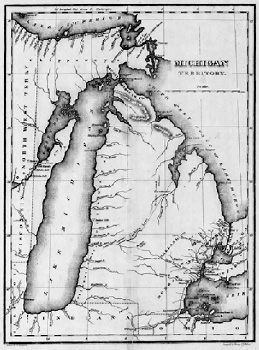That first state charter
The Legal Genealogist is on the road again.
In Grand Rapids, Michigan, to be precise, for tomorrow’s Got Ancestors?! 2017 seminar of the Western Michigan Genealogical Society.
We’re going to have a lot of fun tomorrow at the Grand Rapids Salvation Army Kroc Center, talking about DNA and copyright and lots and lots of tips on how to do genealogy right… Walk-ins are welcome; you’ll need to bring your own lunch. So come on out and join us.
In the meantime, of course, I’m doing my usual review of local laws… and finding some neat stuff in the one of the oldest of Michigan’s chartering documents.
The Constitution of 1835.
 Now… to be complete… the earliest chartering document would be the Northwest Ordinance,1 since the area that is today Michigan was part of the Northwest Territory.2 Then in 1805, the Territory of Michigan was created by Congress,3 and its territorial government ran things until Michigan was admitted as a state in 1837.4
Now… to be complete… the earliest chartering document would be the Northwest Ordinance,1 since the area that is today Michigan was part of the Northwest Territory.2 Then in 1805, the Territory of Michigan was created by Congress,3 and its territorial government ran things until Michigan was admitted as a state in 1837.4
But it was that Constitution of 1835 that served as the governing vehicle to get Michigan admitted… and it’s got some interesting provisions.
Among them were the provision for public schools with a common school system to operate for at least three months every year and funding through a perpetual fund5 that we talked about here yesterday.6
The Constitution also provided for libraries “as soon as the circumstances of the state will permit” and for funding for a state university.7
It provided vehemently that “Neither slavery nor involuntary servitude shall ever be introduced into this state, except for the punishment of crimes of which the party shall have been duly convicted.”8 It contained an extensive bill of rights.9
And there was more. In no particular order:
Voters were the usual white male citizens over the age of 21 years, resident in the state for six months,10 but they had some special protections.
• They couldn’t be arrested while going to and from voting, or during the vote, except in cases of treason, felony, or breach of the peace.11
• They didn’t have to do militia duty on election days except in the time of war or public danger.12
• They wouldn’t lose their residence for voting because they were out of the state on public business,13 but just being stationed there with the military didn’t give them residence for purposes of voting either.14
The Legislature was made up of two houses, each based on population. And its members had some rules they had to live by:
• Neither of the two houses of the Legislature could adjourn without the consent of the other for more than three days nor meet anywhere other than where the legislature was in session.15
• The pay for legislators couldn’t go up during a legislative term.16
• The pay for legislators “shall never exceed three dollars a day.”17
The Governor could adjourn the legislature if the legislators couldn’t figure out how to do it themselves18 and he could make it meet some place other than the capital if it was “dangerous from a common enemy, or a contagious disease.”19
Judges of all courts, right down to the justices of the peace, were elected officials.20
Now… look… I know I’m a law geek. So I find this stuff cool all by itself.
But for those genealogists who have some trouble understanding why I think this is quite so cool… stop and think. Think of the records created as the result of this one document.
The voting records.
The legislative documents.
The records of the governors.
The school records, and land records, and militia lists, and oaths of office, and official notices and…
Sigh…
As genealogists, we can all be so grateful to those who sat down and began constituting Michigan all those years ago…
SOURCES
Image: “Michigan Territory,” in James Finlayson, A Complete Historical, Chronological, and Geographical American Atlas (Philadelphia : Carey and Lea, 1822); reproduced by Michigan State University Libraries, Scanned Maps.
- See “Northwest Ordinance; July 13, 1787,” html version, Yale Law School, Avalon Project (http://avalon.law.yale.edu : accessed 12 Oct 2017). ↩
- See “The Development of Michigan’s Boundaries,” Department of Geography, Environment, & Spatial Sciences, Michigan State University (http://geo.msu.edu/ : accessed 12 Oct 2017). ↩
- “An Act to divide the Indiana Territory into two separate governments,” 2 Stat. 309 (11 Jan 1805). ↩
- Bob Garrett, “The Rough and Rocky Road to Statehood,” Seeking Michigan, posted 25 Jan 2011 (http://seekingmichigan.org/ : accessed 12 Oct 2017). ↩
- Constitution of Michigan of 1835, Article X, ¶¶ 2-3; html version, Legislature of Michigan (http://www.legislature.mi.gov/ : accessed 12 Oct 2017). ↩
- See Judy G. Russell, “Looking back at Michigan lands,” The Legal Genealogist, posted 12 Oct 2017 (https://www.legalgenealogist.com/blog : accessed 13 Oct 2017). ↩
- Constitution of Michigan of 1835, Article X, ¶¶ 4-5. ↩
- Ibid., Article XI. ↩
- Ibid., Article I. ↩
- Ibid., Article II, ¶ 1. ↩
- Ibid., Article II, ¶ 3. ↩
- Ibid., Article II, ¶ 4. ↩
- Ibid., Article II, ¶ 3. ↩
- Ibid., Article II, ¶ 3. ↩
- Ibid., Article IV, ¶ 14. ↩
- Ibid., Article IV, ¶ 18. ↩
- Ibid. ↩
- Ibid., Article V, ¶ 9. ↩
- Ibid., Article V, ¶ 10. ↩
- Ibid., Article VI. ↩



Than you Judy, for a wonderful, entertaining, and fun lectures on a dark, dreary, wet Saturday at “Got Ancestors ’17’, Looking forward to seeing you at the NGS conference in June 2018, the second one I will attend and the first in Grand Rapids and Michigsn.